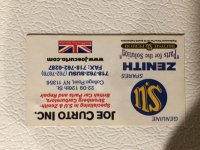Tried to get Baby Blue back out on the road on an unusually warm 71 degree day, but failed. Replaced the fuel line and that seems to be working fine.
Using the Colortune, I found I had to get my rear carb to max rich to keep it from turning orange under acceleration. Front one was somewhere in the middle. When I tried to sync the carbs, the front carb was pulling down MUCH more vacuum, even at idle and the idle screw backed out full, it was pegging the synchronization tool. Meanwhile, the rear carb wouldn't even register. I also did the tube trick and you could hear a huge difference between the front and rear carbs at idle speed. Even when I'd sync the carbs at 2000 rpm and listen to the hiss using the tube, by the time I backed down to idle, they'd be out of whack again.
To top it off, the front float chamber now coughed up gas from the gasket. That's leading me to believe that there is something farther down the line blocking the gas and getting it to back up. I put a new jet in the front carb -- wondering if it is out of whack?
I'm also wondering if I just shouldn't do a full carb overhaul -- new needles, replace the rear jet, too, replace the damper springs...anything else? I'm trying to think if I'm missing something, but I've never had this much of a problem getting the carbs to sync in the past.
Using the Colortune, I found I had to get my rear carb to max rich to keep it from turning orange under acceleration. Front one was somewhere in the middle. When I tried to sync the carbs, the front carb was pulling down MUCH more vacuum, even at idle and the idle screw backed out full, it was pegging the synchronization tool. Meanwhile, the rear carb wouldn't even register. I also did the tube trick and you could hear a huge difference between the front and rear carbs at idle speed. Even when I'd sync the carbs at 2000 rpm and listen to the hiss using the tube, by the time I backed down to idle, they'd be out of whack again.
To top it off, the front float chamber now coughed up gas from the gasket. That's leading me to believe that there is something farther down the line blocking the gas and getting it to back up. I put a new jet in the front carb -- wondering if it is out of whack?
I'm also wondering if I just shouldn't do a full carb overhaul -- new needles, replace the rear jet, too, replace the damper springs...anything else? I'm trying to think if I'm missing something, but I've never had this much of a problem getting the carbs to sync in the past.

 Hi Guest!
Hi Guest!

 smilie in place of the real @
smilie in place of the real @
 Pretty Please - add it to our Events forum(s) and add to the calendar! >>
Pretty Please - add it to our Events forum(s) and add to the calendar! >> 


